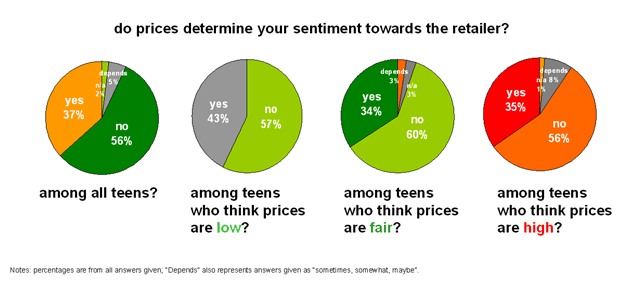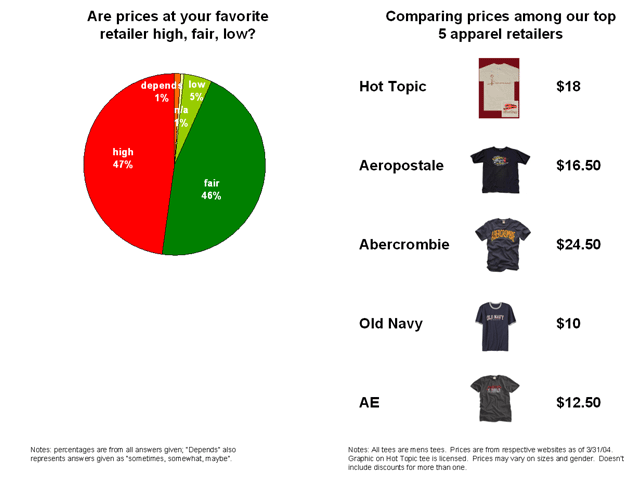management
This past March, I asked
a mall-based retail CEO about his company's pricing strategy - what is it based
on and if perhaps they weren't underpricing. His response was not surprising,
"[Our research shows that] teens usually come to the mall with an average
of $40. So we price accordingly." My theory was that executives don't truly
understand teen value perceptions, particularly with something as misunderstood
as price. So I posed a follow up question: "what do you think would happen
if you raised your prices?" To which he replied, "it wouldn't work,"
without skipping a beat.

Pricing is never easy. You don't want to scare your customers away, but you also want to make money. And the cheap bastard in all of us doesn't ever think anyone would pay more than a buck for anything. The challenge is not in pricing right, but remembering that there are customers out there that are actually willing to pay you more than you'd pay yourself for the same product. In al berrios & co.'s landmark Teen Sentiments Towards Retailers Study, this is apparent in the way the prices at their favorite retailers affect teens'.
When asked if prices determined their sentiment towards a retailer, 56% said no, while only 37% said yes. Although this may appear to be the sort of irrational logic at work we expect from the average teenager, when divided into three categories - teens who think prices at their favorite retailers are low, fair, and high - this groups' logic begins to make sense: among teens who think prices are high, 56% said that price doesn't determine their sentiment towards the retailer, while 35% said yes; among teens who think prices are fair, 60% said no, 34% said yes; but among teens who think prices are low, 57% said no, while 43% said yes, 8-percentage points higher than those who said yes to high prices. What does this mean?
 |
Although speculative, it appears that excessive bargains, sales, discounts, and promotions do alter teens' perceptions of their favorite retailers in the negative more severely than not having them. On the other extreme, high prices keep a retailer exclusive, and thus a favorite among teens, potentially explaining why despite 47% of our teens believing that prices were high, still considered a store their favorite. Considering that the average 15-24 year old in this country makes between twenty-to-twenty-nine thousand annually, their disinterest in being spendthrifts is economically unreasonable, which although common knowledge by any parent, is seldom as statistically obvious.
Consequently, regardless how much money a teen brings to a mall, it is possible to capture a larger percentage of that spending money than common (cheap-bastard) thinking would lead us to believe. After all, teens don't go to the mall to shop, then leave. They go to hang out. So thinking that they'll be less inclined to pay your high prices for fear of running out of money to buy other stuff isn't necessarily the most likely outcome.
Should the teen retailer dash off to raise their prices? No. The lesson isn't that high prices draw teens in like bees to honey. (After all, even your teen research tells you that product quality does still count for something.) The more important take-away is that less discounting maintains teens' positive association (and relationship) with your retail brand.

Write to
Al Berrios at editor@alberrios.com
Top
Related alberrios.com Sections
- Our latest thinking on the retail industry
- Our coverage of retail brands
- Our research
on the retail industry
- Our latest thinking on consumer perceptions
- Our analyses of the latest thinking in the
retail industry
- Learn
more about the retail + restaurant
industries
- Consumer
advocacy
- News about
the retail industry
Top
Disclaimer:
The recommendations, commentary and opinions published herein are based on
public information sometimes referenced via hyperlinks. Any similarities or
likeness to any ideas or commentary from any other sources not referenced
is purely coincidental. al berrios & co. cannot control any results occurring
from advice obtained from this publication nor any opinion(s) conveyed by
any reader of this publication.
al berrios & co. does and seeks to do business with companies covered
in its research reports and studies. As a result, the reader should be aware
that the firm may have a conflict of interest that could affect the objectivity
of this report or study. Readers should consider this report or study as only
a single factor in making any strategic or investment decisions.
(c) 2001-2005. All Rights Reserved. al berrios & company, inc. Published by al berrios & co. This Report may not be reproduced or redistributed in any form without written permission from al berrios & co., subject to penalty.